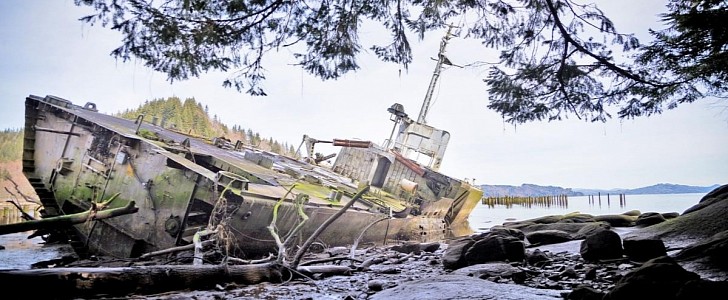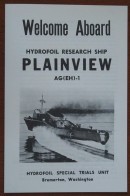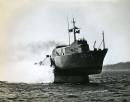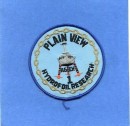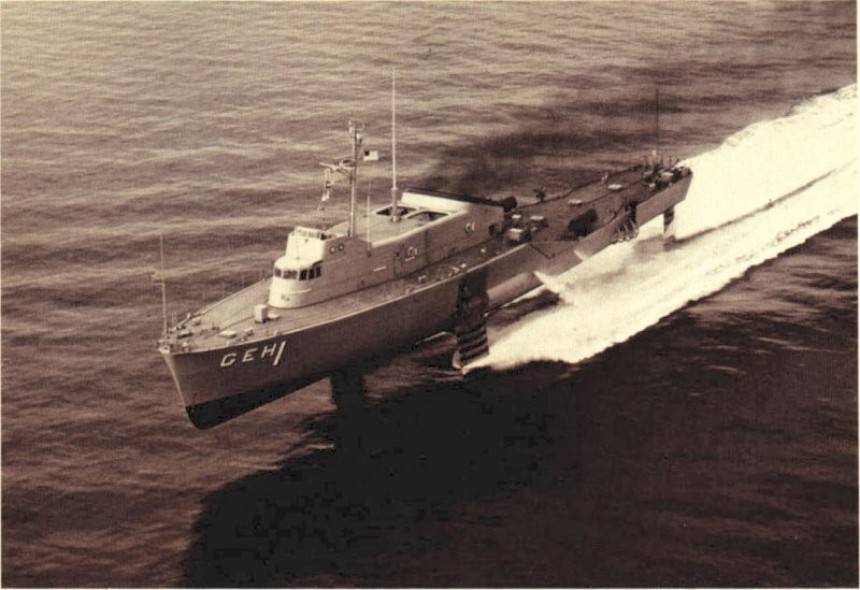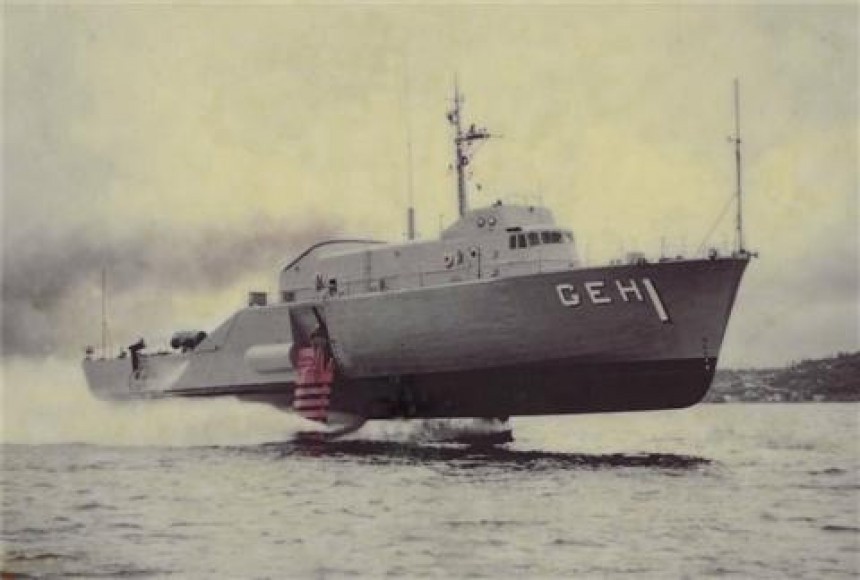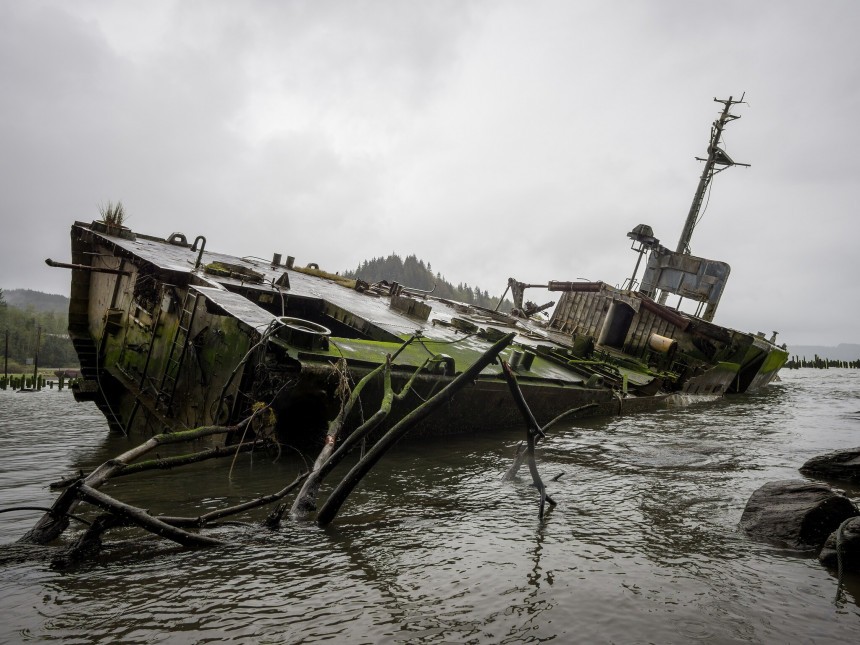As connoisseurs of exciting and quirky land, air, and sea vehicles, we like to think that at least one of each of the most important planes, trains, boats, and cars are well preserved and well celebrated. This fanciful view is reduced to atoms in a matter of seconds after one good look at the present state of what was once the largest and fastest hydrofoil boat in the world.
The USS Plainview is one of the innumerable U.S. Navy ships that didn’t have a well-known service career that cemented its name in the pages of history. Its namesake is borrowed from two small American neighborhoods. One is 35 miles east of New York City on the north shore of Long Island, New York, and the other is located in North Texas, around 50 miles north of Lubbock.
What the USS Plainview lacked in name recognition, it more than makes up for in its ludicrously awesome design. Consisting of what looks like a naval patrol boat blended with two foldable wing-like appendages, the USS Plainview was the largest and fastest hydrofoil in the world. Now, its remains sit partially submerged on the shores of the American northwest port city of Astoria, Oregon, leaking oil and rust-laden water into the surrounding waters.
The story of how the Plainview transformed from a technological flagship for the U.S. Navy to the twisted, rotting hulk of steel is one rooted in the seemingly endless one-upmanship between America and the Soviets during the Cold War.
Conceived as a response to nuclear-powered and nuclear weapon-capable Soviet submarines, the USS Plainview was designed by the Grumman Aerospace Corporation of Bethpage, New York. A town located directly southwest of Plainview, the ship’s namesake where many Grumman employees lived and commuted to work.
USS Plainview ultimately was built by the Seattle-based Lockheed Shipbuilding and Construction Company and launched on June 28th, 1965. Itself a corporate subsidiary of the Lockheed Corporation famous for their distinguished military aircraft.
The USS Plainview construction was overseen by a team of some of the most brilliant engineers in any field of the 20th century, led by legendary aircraft designer Kelly Johnson. All at a time when the company was building icons like the F-104 and the SR-71. Lockheed would invest the equivalent of $140 million in today’s money to build the ship, more than any other hydrofoil in history to that point.
The Navy theorized that large, fast hydrofoils could speed towards incoming enemy sea vessels and deliver a devastating missile strike before Soviet nuclear ballistic missiles could be fired. With this purpose in mind, the Plainview sported one of the most awe-inspiring combinations of powerplants ever fitted to a motorized vehicle on land or at sea.
Two massive marine diesel engines mated to titanium propellers powered the ship while operating as a standard sea vessel. Only when the hydraulic hydrofoil winglets deployed, a pair of General Electric LM1500 free-turbine turboshaft engines fired to life.
Based on the same J79 engines that powered the Lockheed F-104 Starfighter and Mcdonnel-Douglas F-4 Phantom II, they could make the 315 ton USS Plainview glide across the water at a top speed estimated at 40 knots (45.6 mph, 110 kph)
This speed figure dwarfed almost any other military vessel at sea in the mid-1960s and is impressive even today. In its short but undeniably successful career, the USS Plainview set the world record for the largest and fastest hydrofoil in the world, civilian or military. The mighty ship spent a total of just under 270 hours on her hydrofoils while calling Bremerton, Washington, its home port.
Sailors on the USS Plainview used a combination of naval and aviation terminology while on board. The men at the helm who controlled the ship would use words like takeoff, land, and fly. The Plainview’s control room resembled the cockpit of an airliner more than it did a sea vessel, with a large control yoke taking the place of a ship’s wheel.
The mighty Plainview was instrumental in advancements in hydrofoil technology that eventually found their way into the civilian sector. But ultimately, the Navy’s decision that rapid response helicopter and fixed-wing aircraft units were more effective at submarine defense than surface ships doomed the vessel.
She was decommissioned and stricken from the Navy’s record in 1978. Then, the former USS Plainview was purchased by a private buyer for a sum of $128,000. Then was sold again to a Washington state resident called Lowell Stanbaugh. Stanbaugh intended to use the ship as a fishing vessel before loan interest payments forced him to sell it for scrap.
Stanbaugh had the Plainview partially disassembled, removing its hydrofoil winglets, among other major components. But still to this day, what remains of the hull sits partially submerged in mudflats on private property just adjacent to the Astoria bridge in Oregon, just inside the mouth of the Columbia River. Local environmental officials have expressed concerns about the remains of the ship’s oil and rusted metal polluting and even poisoning the local ecosystem.
Lead and asbestos were common materials in the days the former USS Plainview sailed. There’s concern that it’s only a matter of time before corrosion breaches its containment and spills it into the surrounding waters. The miserable state the once highly touted ship sits in today can only lead one to wonder if it could have been better used as a museum ship instead of spilling its proverbial guts into the Pacific Ocean. It’s a needless loss the Navy likely wants to forget.
What the USS Plainview lacked in name recognition, it more than makes up for in its ludicrously awesome design. Consisting of what looks like a naval patrol boat blended with two foldable wing-like appendages, the USS Plainview was the largest and fastest hydrofoil in the world. Now, its remains sit partially submerged on the shores of the American northwest port city of Astoria, Oregon, leaking oil and rust-laden water into the surrounding waters.
The story of how the Plainview transformed from a technological flagship for the U.S. Navy to the twisted, rotting hulk of steel is one rooted in the seemingly endless one-upmanship between America and the Soviets during the Cold War.
Conceived as a response to nuclear-powered and nuclear weapon-capable Soviet submarines, the USS Plainview was designed by the Grumman Aerospace Corporation of Bethpage, New York. A town located directly southwest of Plainview, the ship’s namesake where many Grumman employees lived and commuted to work.
The USS Plainview construction was overseen by a team of some of the most brilliant engineers in any field of the 20th century, led by legendary aircraft designer Kelly Johnson. All at a time when the company was building icons like the F-104 and the SR-71. Lockheed would invest the equivalent of $140 million in today’s money to build the ship, more than any other hydrofoil in history to that point.
The Navy theorized that large, fast hydrofoils could speed towards incoming enemy sea vessels and deliver a devastating missile strike before Soviet nuclear ballistic missiles could be fired. With this purpose in mind, the Plainview sported one of the most awe-inspiring combinations of powerplants ever fitted to a motorized vehicle on land or at sea.
Two massive marine diesel engines mated to titanium propellers powered the ship while operating as a standard sea vessel. Only when the hydraulic hydrofoil winglets deployed, a pair of General Electric LM1500 free-turbine turboshaft engines fired to life.
This speed figure dwarfed almost any other military vessel at sea in the mid-1960s and is impressive even today. In its short but undeniably successful career, the USS Plainview set the world record for the largest and fastest hydrofoil in the world, civilian or military. The mighty ship spent a total of just under 270 hours on her hydrofoils while calling Bremerton, Washington, its home port.
Sailors on the USS Plainview used a combination of naval and aviation terminology while on board. The men at the helm who controlled the ship would use words like takeoff, land, and fly. The Plainview’s control room resembled the cockpit of an airliner more than it did a sea vessel, with a large control yoke taking the place of a ship’s wheel.
The mighty Plainview was instrumental in advancements in hydrofoil technology that eventually found their way into the civilian sector. But ultimately, the Navy’s decision that rapid response helicopter and fixed-wing aircraft units were more effective at submarine defense than surface ships doomed the vessel.
Stanbaugh had the Plainview partially disassembled, removing its hydrofoil winglets, among other major components. But still to this day, what remains of the hull sits partially submerged in mudflats on private property just adjacent to the Astoria bridge in Oregon, just inside the mouth of the Columbia River. Local environmental officials have expressed concerns about the remains of the ship’s oil and rusted metal polluting and even poisoning the local ecosystem.
Lead and asbestos were common materials in the days the former USS Plainview sailed. There’s concern that it’s only a matter of time before corrosion breaches its containment and spills it into the surrounding waters. The miserable state the once highly touted ship sits in today can only lead one to wonder if it could have been better used as a museum ship instead of spilling its proverbial guts into the Pacific Ocean. It’s a needless loss the Navy likely wants to forget.
